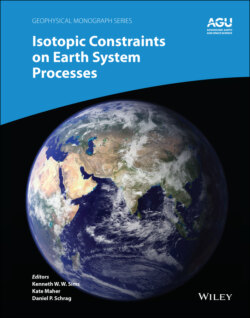Читать книгу Isotopic Constraints on Earth System Processes - Группа авторов - Страница 60
Model for the Isotope Ratio Profiles
ОглавлениеModel isotope ratio profiles are generated by invoking a difference in diffusivity between the isotopes of an element. The dependence of diffusivity on mass can be written as (Richter et al., 1999):
(2.9)
where β is a dimensionless empirical parameter. Here, m refers to the isotopic mass and not the mass of an isotopically substituted molecule such as, for example, CaAl2O4. This functional form is based on principles from the kinetic theory of gases, but it’s also convenient because it normalizes out the fractional mass difference between isotopes, thereby allowing for direct comparison between different isotopic systems.
To model the isotope ratio profiles, we assume the rhyolite and phonolite have the same isotopic composition since they are within error of each other with respect to δ 44Ca. Although we did not directly measure the δ 41K of either starting material, the assumption that they are the same can be justified on the basis that the global range in δ 41K of igneous rocks and minerals is < 1‰ (Morgan et al., 2018). We assume further that the equilibrium isotope ratio profile is uniform at all times; i.e., Ce, 44 is defined to be proportional to Ce, 40 such that the ratio Ce, 44/Ce, 40 is constant, which implies that there is no equilibrium isotopic partitioning between the liquids. Hence, any isotopic fractionations in the model arise solely from diffusive fluxes and the difference in isotopic diffusion coefficients.
Model isotopic profiles are compared to the data in the bottom panels of Fig. 2.7. For Ca isotopes, no single set of parameters ( , Db, Cf, and β ) can explain the full profile or its time evolution reflected in the 2.5‐ and 6‐hour runs. Nevertheless, the fits are qualitatively no worse than those used to estimate β factors and associated uncertainties in other natural silicate liquid diffusion couple experiments (Richter et al., 2003; Watkins et al., 2009). By plotting model curves corresponding to different values of β against the data, we estimate β = 0.10 ± 0.02. This is a somewhat crude estimate, however, and appears to be on the low side for the rhyolite while fitting the phonolite in the 2.5‐hour run, and on the low side for the phonolite while fitting the rhyolite in the 6‐hour run. For K isotopes, we estimate β = 0.25 ± 0.03, which is comparable to the value for Li ( β = 0.21–0.23) in basalt‐rhyolite and rhyolite‐rhyolite diffusion couples (Holycross et al., 2018; Richter et al., 2003).
